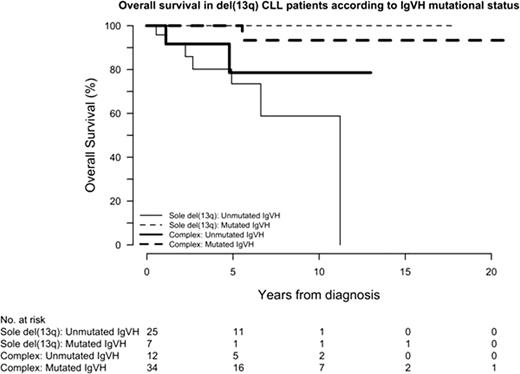Abstract
Abstract 2419
While the del (13q) is generally considered to portend an indolent course in CLL, there remains a subset of these patients who exhibit an aggressive clinical course. Although there is little published data on the clinical course of del (13q) CLL patients who also harbor unmutated IgVH, based on preliminary observations we hypothesized that IgVH mutational status may be prognostic in these patients. We screened 196 CLL patients seen at Johns Hopkins between January 2004 and June 2010 and identified 94 patients whose initial FISH evaluation revealed a del (13q); 79 of these also had an IgVH sequence analysis. Unmutated IgVH was found in 38/79 (48%) of the del (13q) CLL patients; baseline characteristics of age, stage of disease, prior therapy and time to first evaluation at Johns Hopkins were similar in these patients when compared to those with mutated IgVH. Accordingly, a Rai stage ≤2 was documented in 35 (92%) of the unmutated and 35 (85%) of the mutated patients at the time of their first evaluation at Johns Hopkins, and >75% in each group were treatment naïve at that time. Unmutated patients were more likely to have additional chromosomal aberrations as compared to mutated patients (66% versus 17%, p<0.001), respectively. During a median follow-up of 4.5 years for each group, unmutated del (13q) patients were also more likely to demonstrate Rai stage progression (72% versus 40%, p=0.01), with Rai stage 3/4 disease or Richter's transformation occurring more commonly in the unmutated group (57% versus 22%. p=0.002). The cumulative probabilities of receiving treatment and mortality were also higher in the unmutated group. The 5-year treatment-free actuarial survival for unmutated patients was 34% compared to 67% for the mutated group (p = 0.002). The 5 year overall actuarial survival estimate for the unmutated patients was 75% compared to 100% for the mutated group (p = 0.03). When limiting the analysis to the 46 patients with del (13q) as the sole chromosomal aberration, the incidence of unmutated disease is less common (28%) but, importantly, similar trends were seen. The 13 unmutated patients with del (13q) as the sole abnormality were also more likely to have Rai stage progression (67% versus 41%, p=0.18), with the Rai stage3/4 disease or Richter's transformation occurring more commonly in the unmutated group (50% versus 24%. p=0.14). Among those with (del)13q as the sole abnormality, the 5-year treatment-free and overall actuarial survivals for the unmutated group was 39% and 68% compared to 68% (p=0.03) and 100% (p=0.16) in the mutated group, respectively. These data confirm that del (13q) conveys an indolent course for CLL patients, but only in the setting of mutated IgVH. Although neither the mutated nor unmutated patients represented an advanced, chemotherapy-refractory group at initial presentation, we found that unmutated IgVH in patients with a del (13q)(as a sole abnormality or with other chromosomal aberrations) exhibited significantly more aggressive disease. Unmutated del (13q) CLL patients appear to have a prognosis similar to other CLL patients with unmutated IgVH.
Swinnen: Genentech: Membership on an entity's Board of Directors or advisory committees, Research Funding.
Author notes
Asterisk with author names denotes non-ASH members.


This feature is available to Subscribers Only
Sign In or Create an Account Close Modal